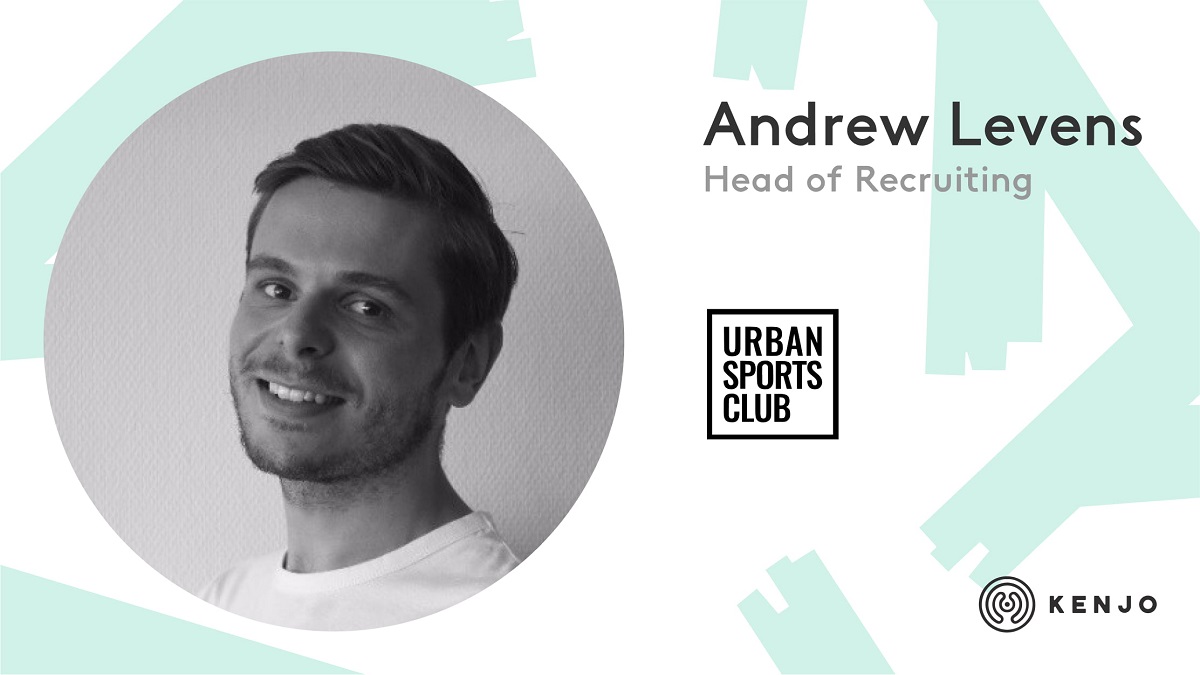Hypergrowth seems to be the holy grail of corporate management for many entrepreneurs and investors, especially in the startup universe. After all, rapid growth is the ultimate goal of all entrepreneurs.
However, rapid growth stages within a company also come with a variety of challenges, that either make or break the organisation.
To get to know more about the right strategies and tools of fast-growing companies, we’ve invited Andrew Levens to our office in Berlin.
 As Head of Recruiting at Urban Sports Club, Andrew Levens knows how to guide companies through each stage of hypergrowth and building recruiting teams in multiple locations. USC is not the first startup that Andrew has been involved in during hypergrowth. At N26, he already expanded their workforce from 200 to 1,300 employees. In our interview with Andrew we learn about important measurements to take while scaling up a hypergrowth organisation:
As Head of Recruiting at Urban Sports Club, Andrew Levens knows how to guide companies through each stage of hypergrowth and building recruiting teams in multiple locations. USC is not the first startup that Andrew has been involved in during hypergrowth. At N26, he already expanded their workforce from 200 to 1,300 employees. In our interview with Andrew we learn about important measurements to take while scaling up a hypergrowth organisation:
Watch the video here or keep reading to learn more about the different growth stages in companies and how to avoid difficulties.
What is hypergrowth anyway?
Modern day technology has had a huge impact on the global economy. It also has opened the door for innovative business models, new forms of stakeholder management and massive market expansion. At the same time, these upheavals are changing the structures of companies and entire industries. The impressive speed of scaling sometimes amazes even experts.
In hypergrowth environments when companies seriously are scaling up oftentimes the average annual growth rate of a company is 40% or more. Incidentally, this is known as the Compound Annual Growth Rate, the CAGR.
The challenges of small business growth
Such an enormous growth rate naturally comes along with corresponding challenges that are impacting the global economy. Talent shortages and regulatory barriers are just some of them. Some of the five biggest challenges for hypergrowth start-ups are:
- Regulation
- Technology
- Business models
- Skilled labour
- Funding and finances
Andrew tells us that while working at Urban Sports Club, his team had to organise the relocation of 300 employees while simultaneously carrying out the onboarding of thirty new employees. He explains that "there was no stopping. Even a huge office move couldn't stop us at that point from still growing and still delivering."
At the same time he addresses an important point:
“In most other traditional organisations a lot of people work for the company and then outgrow the company over a period of years. In hyper-growth organisations where things are changing so rapidly and the company shifts on a daily, weekly, monthly basis, the company outgrows its people instead.”
Andrew Levens
So by their very nature, employees cannot keep up with the change. Often there are so many changes in the management and team structure that employees stop counting. Here the HR departments and recruitment are at the centre of these change management processes.

Finding right employees when scaling up
Part of the daily business of hypergrowth startups is autonomy, flexibility and controlled chaos. There are no established routines and every day is a new surprise of business development.
Thus, finding the right team plays an extremely important role in the success of a hypergrowth company. At this stage, each HR manager at Urban Sports Club conducted six to seven interviews a day to get appropriate teams for the rapidly growing tasks.
This hypergrowth of course can then lead to internal conflicts and a culture clash. After all, two very different mindsets meet at one stage. On the one hand, you have the startup mentality where every employee is a jack-of-all-trades and is involved in many things at once. On the other hand, you have the professional mindset of many established companies that focuses on traditional expertise and skills.
For Andrew, empathy is the key to resolving these conflicts. Human resource managers must be able to put themselves in the employees' shoes to understand why they might be emotionally resistant to the current change management processes. In times of rapid growth, emotional leadership in change management is crucial.

Goals of a hypergrowth startup
Andrew emphasises that one of the most important goals of all recruiting teams should be to build a sustainable business. No matter what stage the company is in, these questions should be standard to every HR manager:
- Are the new hires 100 percent necessary?
- Do we really need this or is this a nice-to-have?
- Are basic salaries, rewards and remuneration structures fair and not artificially inflated?
During the COVID-19 crisis Andrew learned that many startups and scaleups had become artificially bloated in some ways in recent years - in terms of team size, but also in terms of salary, rewards and compensation structure.
In this sense, he sees the role of recruiting as a champion that helps executives throughout the organisation to think about organisational growth.
Recruitment therefore plays a pivotal role of any well-functioning hypergrowth startup.
Thank you Andrew for your insights into a topic we can’t hear enough about.
Find out about the latest HR trends 2020 in an interview with our investor Noor van Boven.

 As Head of Recruiting at
As Head of Recruiting at 

